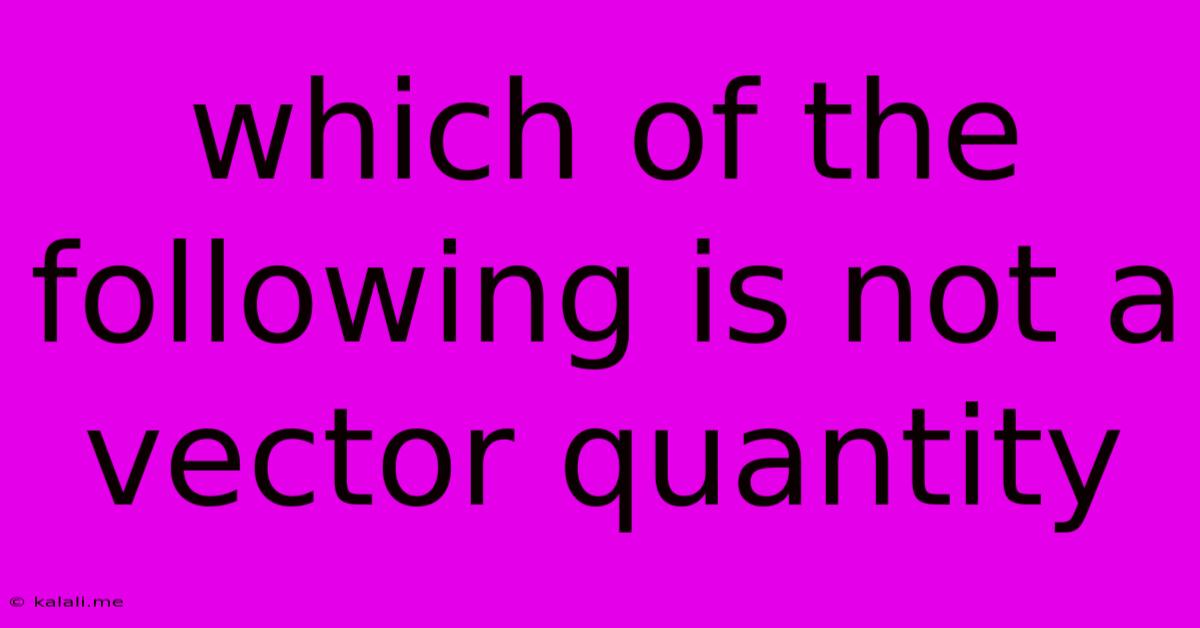Which Of The Following Is Not A Vector Quantity
Kalali
Jun 12, 2025 · 3 min read

Table of Contents
Which of the Following is NOT a Vector Quantity? Understanding Scalars and Vectors
This article will delve into the crucial difference between scalar and vector quantities, ultimately answering the question: which of the following is NOT a vector quantity? We'll explore the characteristics of each, providing clear examples to solidify your understanding. This is essential knowledge for physics, engineering, and other scientific fields.
What are Vector Quantities?
Vector quantities possess both magnitude (size or amount) and direction. Think of it like giving directions – you need to know how far (magnitude) and which way (direction) to go. Examples of vector quantities include:
- Displacement: The change in position of an object. It's different from distance, which is a scalar. A displacement of 10 meters east is different from a displacement of 10 meters west.
- Velocity: The rate of change of displacement. It describes how fast something is moving and in what direction. A velocity of 50 km/h north is different from 50 km/h south.
- Acceleration: The rate of change of velocity. It also has both magnitude and direction.
- Force: A push or pull on an object. A force of 10 Newtons upwards is different from a force of 10 Newtons downwards.
- Momentum: The product of an object's mass and velocity. Since velocity is a vector, momentum is also a vector.
What are Scalar Quantities?
Scalar quantities only have magnitude. Direction is irrelevant. Examples of scalar quantities include:
- Speed: The rate of change of distance. It only tells you how fast something is moving, not the direction.
- Distance: The total length of the path traveled. It doesn't matter which direction you went, only how far you went.
- Mass: The amount of matter in an object.
- Temperature: A measure of how hot or cold something is.
- Time: The duration of an event.
- Energy: The capacity to do work.
- Volume: The amount of space occupied by an object.
Identifying Non-Vector Quantities
Now, let's address the core question. To determine which of a given list is NOT a vector quantity, you need to identify the quantities that lack direction. For example, if you're given a list containing: velocity, mass, force, and acceleration, the answer would be mass. Mass only has magnitude; it doesn't have a direction associated with it. Similarly, speed, distance, temperature, energy and volume are all scalar quantities and would be correct answers if included in such a question.
Visual Representation
Vectors are often represented graphically using arrows. The length of the arrow represents the magnitude, and the arrowhead indicates the direction. Scalars, on the other hand, are simply represented by a numerical value. Understanding this visual representation can greatly aid in distinguishing between the two.
Conclusion
The distinction between scalar and vector quantities is fundamental in physics and related fields. By understanding the concepts of magnitude and direction, you can easily identify which quantities are vectors and which are scalars. Remember to look for the direction component to solve the question: "Which of the following is NOT a vector quantity?". Mastering this distinction is crucial for accurately representing and solving problems involving physical quantities.
Latest Posts
Latest Posts
-
Which Of The Following Is Not A Personal Computer
Jun 13, 2025
-
Webcam Is Input Or Output Device
Jun 13, 2025
-
A Kilobyte Is Equal To Approximately One Bytes
Jun 13, 2025
-
Glucose Is Stored In Plants In The Form Of
Jun 13, 2025
-
Which Layer Is The Closest To Earth
Jun 13, 2025
Related Post
Thank you for visiting our website which covers about Which Of The Following Is Not A Vector Quantity . We hope the information provided has been useful to you. Feel free to contact us if you have any questions or need further assistance. See you next time and don't miss to bookmark.